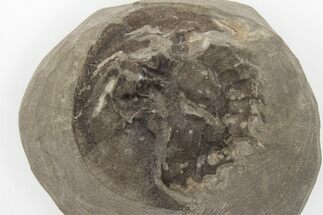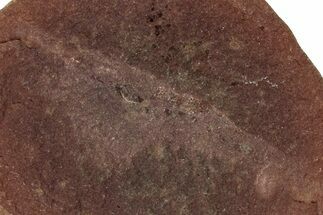This Specimen has been sold.
Huge, Fossil Anomolocarid Grasping Appendage - Cambrian
This is a huge, soft-bodied, fossil Anomolocarid grasping appendage from the Middle Cambrian, Jbel Wawrmast Formation of Morocco. Around the curve it measures 7 to 8" and is preserved with a lot of detail. Even isolated appendages of this intriguing arthropod are quite rare and this is the largest I've seen.
Both the positive and negative split is included along with a pair of display stands.
Both the positive and negative split is included along with a pair of display stands.
About Anomalocarids
Anomalocarids, meaning "anomalous shrimp," are an extinct group of large, predatory marine arthropods that thrived during the Cambrian and early Ordovician periods. They are among the most iconic creatures of the Cambrian explosion, a time of rapid diversification of life over 500 million years ago. Belonging to the family Anomalocarididae, these animals are often regarded as some of the earliest apex predators, with specialized adaptations that allowed them to dominate Cambrian seas.
Anomalocarids were unique in appearance, characterized by their large, segmented bodies and a distinct pair of spiny appendages near their mouths. These appendages, shaped like "fronds" or "lobes," were flexible and likely used to grasp prey, funneling it toward their circular mouths, which were lined with sharp, overlapping plates. This structure, sometimes called a "pineapple-slice" mouth, allowed them to crush the exoskeletons of trilobites and other prey. Anomalocarids also possessed large, stalked eyes, giving them excellent vision, a vital trait for hunting in the open sea.
Their bodies were long and streamlined, with a series of lateral flaps running along the sides. These flaps acted like fins, allowing anomalocarids to swim gracefully through the water. Some anomalocarid species, such as Anomalocaris canadensis and Hurdia victoria, grew over a meter in length, making them formidable predators compared to most Cambrian marine life, which was typically quite small.
Anomalocarids, meaning "anomalous shrimp," are an extinct group of large, predatory marine arthropods that thrived during the Cambrian and early Ordovician periods. They are among the most iconic creatures of the Cambrian explosion, a time of rapid diversification of life over 500 million years ago. Belonging to the family Anomalocarididae, these animals are often regarded as some of the earliest apex predators, with specialized adaptations that allowed them to dominate Cambrian seas.
Anomalocarids were unique in appearance, characterized by their large, segmented bodies and a distinct pair of spiny appendages near their mouths. These appendages, shaped like "fronds" or "lobes," were flexible and likely used to grasp prey, funneling it toward their circular mouths, which were lined with sharp, overlapping plates. This structure, sometimes called a "pineapple-slice" mouth, allowed them to crush the exoskeletons of trilobites and other prey. Anomalocarids also possessed large, stalked eyes, giving them excellent vision, a vital trait for hunting in the open sea.
Their bodies were long and streamlined, with a series of lateral flaps running along the sides. These flaps acted like fins, allowing anomalocarids to swim gracefully through the water. Some anomalocarid species, such as Anomalocaris canadensis and Hurdia victoria, grew over a meter in length, making them formidable predators compared to most Cambrian marine life, which was typically quite small.
SPECIES
Unidentified
AGE
LOCATION
Nkob, Morocco
FORMATION
Jbel Wawrmast Formation
SIZE
7 to 8" around curve
CATEGORY
ITEM
#307249
We guarantee the authenticity of all of our specimens.
 Reviews
Reviews















